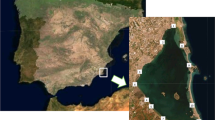Abstract
The results of the present research study indicate that the heavy metal accumulation in the marine sponges provide evidence as an excellent bioindicators for monitoring heavy metal pollution between near and offshore environments of Mandapam coast of “Gulf of Mannar (GoM), India”. The heavy metal concentrations in sea water and accumulation in the tissues of Haliclona tenuiramosa were analyzed by ICP-MS (inductively coupled plasma-mass spectrometry). The concentrations of metals in the coastal waters of nearshore (< 0.5 km from shore) were always higher than those in the offshore waters (2–5 km away from shore). Likewise, sponges living in the nearshore accumulated greater concentrations of heavy metals (As, Cd, Co, Cu, Fe, Mn and Ni) ranging from 2 to 17 times higher concentration than the sponges located away from the shore. A positive correlation between concentration levels in water and bioaccumulation in tissues was observed. The bioaccumulation of heavy metals in sponge tissue were in order of Fe > Mn > Ni > Cu > As > Co > Cd in both the near and offshore stations. The present results justified that a more comprehensive monitoring of presence of heavy metals in H. tenuiramosa of surrounding GoM, is necessary to help a better mitigation of the problem.
Similar content being viewed by others
References
Berthet, B. B., Catherine, M. C., Thierry Pérez, T., & Amiard-Triquet, C. (2005). Metallothionein concentration in sponges (Spongia officinalis) as a biomarker of metal contamination. Comparative Biochemistry and Physiology C, 141(3), 306–313.
Brooks, R. R., Presley, B. J., & Kaplan, I. R. (1967). APDC-MIBK extraction system for the determination of trace elements in saline waters by atomic-absorption spectrophotometry. Talanta, 14(7), 809–816. doi:10.1016/0039-9140(67)80102-4.
Carballo, J. L., & Naranjo, S. (2002). Environmental assessment of a large industrial marine complex based on a community of benthic filter feeders. Marine Pollution Bulletin, 44(7), 605–610. doi:10.1016/S0025-326X(01)00295-8.
Carballo, J. L., Naranjo, S. A., & Garcia-Gómez, J. C. (1996). Use of marine sponges as stress indicators in marine ecosystems at Algeciras Bay (Southern Iberian Peninsula). Marine Ecology Progress Series, 135, 109–122. doi:10.3354/meps135109.
Cebrian, E., Mart, R., Agell, G., & Uriz, M. J. (2006). Response of the Mediterranean sponge Chondrosia reniformis Nardo to heavy metal pollution. Environmental Pollution, 141, 452–458. doi:10.1016/j.envpol.2005.08.070.
Cebrian, E., Mart, R., Uriz, M. J., & Turon, X. (2003). Sublethal effects of contamination on the Mediterranean sponge Crambe crambe: Metal accumulation and biological responses. Marine Pollution Bulletin, 46, 1273–1284. doi:10.1016/S0025-326X(03)00190-5.
EPA (1986). The Environment (Protection) Act, No: 29. Ministry of Environment and Forests, (Department of Environment, Forest and Wildlife). Government of India.
Hansen, I. V., Weeks, J. M., & Depledge, M. H. (1995). Accumulation of Copper, Zinc, Cadmium, and Chromium by the Marine sponge Halichondria panicea Pallas and the implications for Biomonitoring. Marine Pollution Bulletin, 31(1–3), 133–138. doi:10.1016/0025-326X(94)00228-2.
Jonathan, M. P., & Ram-Mohan, V. (2003). Heavy metals in sediments of the inner shelf of Gulf of Mannar, South East Coast of India. Marine Pollution Bulletin, 46(2), 263–268. doi:10.1016/S0025-326X(02)00484-8.
Jonathan, M. P., Ram-Mohan, V., & Srinivasalu, S. (2004). Geochemical variations of major and trace elements in recent sediments, of the Gulf of Mannar, the Southeast coast of India. Environmental Geology, 45(4), 466–480. doi:10.1007/s00254-003-0898-7.
Krishnamoorthy, R., Devasenapathy, J., Thanikachalam, M., & Ramachandran, S. (2003). Environmental and human impacts on coastal and marine protected areas in India. In G. Visconti, M. Beniston, E. D. Iannorelli & D. Barba (Eds.), Global change and protected areas (Vol. 9, pp. 373–392). The Netherlands: Springer.
Mc Carthy, H. T., & Ellis, P. C. (1991). Comparison of microwave digestion with conventional wet ashing and dry ashing digestion for analysis of lead, cadmium, chromium, copper, and zinc in shellfish by flame atomic absorption spectroscopy. Journal—Association of Official Analytical Chemists, 74(3), 566–569.
Patel, B., Balani, M. C., & Patel, S. (1985). Sponge ‘sentinel’ of heavy metals. The Science of the Total Environment, 41(2), 143–152. doi:10.1016/0048-9697(85)90184-6.
Perez, T., Wafo, E., Fourt, M., & Vacelet, J. (2003). Marine sponges as biomonitor of poly-chlorobiphenyls contamination: Concentration and fate of 24 congeners. Environmental Science & Technology, 37(10), 2152–2158. doi:10.1021/es026234v.
Rajendran, B. R., Imagawa, T., Tao, H., & Ramesh, R. (2005). Distribution of PCBs, HCHs and DDTs, and their ecotoxicological implications in Bay of Bengal, India. Environment International, 31(4), 503–512. doi: 10.1016/j.envint.2004.10.009.
Ramesh, R., Purvaja, R., Ramesh, S., & James, R. A. (2002). Historical pollution trends in coastal environments of India. Environmental Monitoring and Assessment, 79(2), 151–176. doi:10.1023/A:1020250717093.
Venkataraman, K., & Waffar, M. (2005). Coastal and marine biodiversity of India. Indian Journal of Marine Sciences, 34(1), 57–75.
Venkateswara Rao, J., Kavitha, P., Chakra Reddy, N., & Gnaneshwar Rao, T. (2006). Petrosia testudinaria as a biomarker for metal contamination at Gulf of Mannar, southeast coast of India. Chemosphere, 65, 634–638. doi:10.1016/j.chemosphere.2006.01.072.
Venkateswara Rao, J., Kavitha, P., Srikanth, K., Usman, P. K., & Gnaneshwar Rao, T. (2007). Environmental contamination using accumulation of metals in marine sponge, Sigmadocia fibulata inhabiting the coastal waters of Gulf of Mannar, India. Toxicological & Environmental Chemistry, (Taylor & Francis Journal), 89(3), 487–498.
Vogel, S. (1977). Current-induced flow through living sponges in nature. Proceedings of the National Academy of Sciences of the United States of America, 74(5), 2069–2071. doi:10.1073/pnas.74.5.2069.
Zahn, R. K., Zahn, G., Muller, W. E. G., Kurelec, B., Rijavec, M., Batel, R., et al. (1981). Assessing consequences of marine pollution by hydrocarbons using sponges as model organisms. The Science of the Total Environment, 20(2), 147–169. doi:10.1016/0048-9697(81)90060-7.
Author information
Authors and Affiliations
Corresponding author
Rights and permissions
About this article
Cite this article
Venkateswara Rao, J., Srikanth, K., Pallela, R. et al. The use of marine sponge, Haliclona tenuiramosa as bioindicator to monitor heavy metal pollution in the coasts of Gulf of Mannar, India. Environ Monit Assess 156, 451–459 (2009). https://doi.org/10.1007/s10661-008-0497-x
Received:
Accepted:
Published:
Issue Date:
DOI: https://doi.org/10.1007/s10661-008-0497-x




